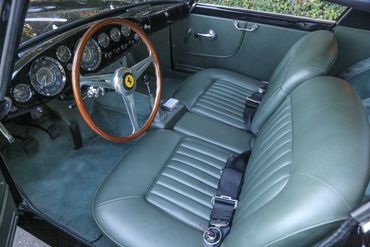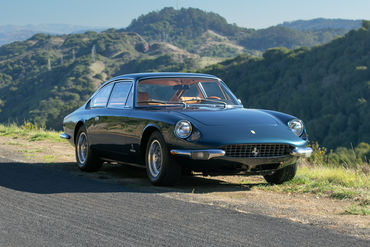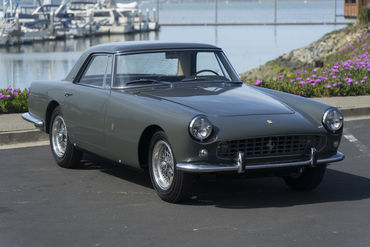Sold
SOLD 03/20
1958 Ferrari
250 GT Coachwork by Carrozzeria Ellena
Attractive, Restored, Matching Numbers Example of an Elegant and Timeless 250 Series Ferrari.
- VIN0861GT
- Exterior ColorBlack with Silver Roof
- Interior ColorGreen Leather
- Mileage5438 Kilometers (TMU)
- Engine2.9 Liter SOHC V12
- Engine no.0861GT
- Transmission4-Speed Manual
- StatusSold
- StockFJ2369
Description
1958 Ferrari 250 GT Coachwork by Carrozzeria Ellena
s/n 0861 GT, engine no. 0861 GT
Black and Silver with Green Leather Interior
The 1950s was a pivotal decade for Ferrari. Leading virtually every race, besting top competitors at premier racing venues, and garnering world press, one would have to believe Ferrari was at the top of their game. But behind closed doors, the company was struggling to earn the money they desperately needed to compete against larger companies where racing programs were highly funded by sales of production cars. As part of Ferrari’s increased intentions to improve their financial stability, it was clear that cultivating a series of volume production road cars for customer sale would be a critical component to their survival. Producing serious road cars was not only fiscally important, it was also a big part of showcasing proven racing technology, especially in the rapidly growing North American market. To meet this market the offerings had to be elegant, understated, and luxurious, available as both open and closed variants. Ultimately the first of these volume production road cars, the Europa would yield only twenty examples of this period, but it was an important start.
It would take several more years before the first of the more refined Ferrari 250 GT road cars would arrive, essentially becoming the quintessential Ferrari, in part due to their powerful 3-litre V-12, but also due to the beautiful Pininfarina body design. Unable to supply the volume needed to meet the production demands, Ferrari moved the project to Boano, who agreed to take on the line after only a few Pininfarina prototypes had been built. Under the name Boano, 82 cars were built before Boano founders, the father Mario Felice Boano (himself an ex-Farina designer) and son Gian Paolo departed to join Fiat at the end of 1957. Ezio Ellena, son-in-law to Boano, took the helm, rightfully renaming the firm Carrozzeria Ellena. Under his name, approximately 50 cars were completed before production closed.
Among the many changes incorporated into the Ellena series cars, the roof was raised 2” to accommodate taller drivers, a standard 4 speed shift pattern gearbox was adopted, larger brakes, a ZF steering system, and the engine converted to single distributor ignition. Not only were these road cars stylish, offering softer ride, lighter steering, and synchromesh gearboxes, they delivered unrivaled road performance in part because they utilized essentially the same components as Ferrari competition cars. Indeed with 4.57 gears 0-60 times were under 6.0 seconds and top speeds could achieve 157mph. Celebrated in period press and ultimately setting the stage for Ferrari to become recognized as a new leader in volume sportscar manufacturing. Although marketed as the premier luxury performance offering for road use, several of this series competed successfully in various races including running in the Mille Miglia, scoring an Alpine Rally GT Class win, and an overall victory in the 1957 Acropolis Rally.
According factory build sheets and the Marcel Massini Report prepared for this car, construction for #0861 GT began January 7, 1958. The chassis was dispatched to Carrozzeria Ellena January 10, 1958, with engine assembly April 11, 1958, and final completion noted on April 14, 1958. Later that year, the car was sold to the first owner, Antonio Fiorani of Modena, Italy, who very likely paid close to $11,000.00 for what Richie Ginther called “A Grand Touring Masterpiece”, a sum more than triple that of a brand new Cadillac. In 1959 the car was imported to the US by Luigi Chinetti Motors, NY. That same year, Fitzgerald Motors, a Jeep and Renault dealership, acquires the car.
In 1970 Fitzgerald motors sells the car to Mr. Bradley E. Bales of Dallas, TX for the price of $3,250.00, including trade value for a 1967 Ford Mustang. At the time of purchase, the car is painted black, and is believed to be the original color, however this has not been verified by Massini or extant factory records. In 1972, Balles engages John Hajduk of Motorkraft in Bensenville, IL to rebuild the engine. Balles retains the car a remarkable 32 years, performing a restoration in 2002 in preparation for sale. Jack Boxstrum purchases the car from RM Auctions in 2002. Boxstrum spends the next decade of his ownership driving the car in several historic race events. In 2003 Boxstrum attends the 8thAnnual Amelia Island Concours with the car, but it remains in the delivery truck due to heavy rainfall. In May, 2004 Boxstrum drives in the Highlands Classic, NC and later in July at the Ferrari & Maserati Festival and Shell Historic Challenge Races at Lime Rock Park, CT (ref. race 656). While at the races, Boxstrum is offered $225,000.00 for the car by Nick Soprano’s Motor Classic, NY, but Boxstrum declines the offer. In 2008 Boxstrum and his wife drive in the Colorado Grand with the car. By 2012, the car is listed as lot #226 at RM Auctions, Scottsdale, AZ with a $450k-550k estimate. Although the high bid achieved was $400,000.00, the car remained unsold. Later that same year, the car sells at RM Auctions, London to dealer Ken Sterne of G&S Motors, Arden, NC, a buyer’s agent for the current owner. After purchase, the car is imported back to the US and subsequently restored by Jim Verhey of Reincarnation Auto, CO between 2015 and 2017 with the interior also being restored in 2018 by CarClassic. During the restoration process every portion of the mechanical refurbishment was documented with high resolution photography.
During consignment, Ferrari expert Patrick Ottis road tested the car and removed all wheels to perform a detailed inspection of the brakes and suspension. The rear axle seal was removed and replaced, and both the front and rear brake shoes were adjusted to have even contact when activated. Hubs (including repacking bearings) and various brake hardware (also resealing wheel cylinders) were reinstalled and torqued to correct specifications, including installing correct hub spacer cones. During the brake service, the master cylinder was also removed, honed, and resealed, then tested for operation before reinstallation, then the car was road tested, returning with good braking results. After the brake work was performed, the car was further tested revealing poor performance from a non-original specification starter motor. An Ottis supplied, fully reconditioned Marelli starter motor was installed along with corrected wiring. As part of this process, the battery cable, starter relay, bottom cable, and signal wire were also replaced to original specifications. Two detailed invoices from Ottis total over $11,000.00 for this recent work.
Today, this Ferrari 250GT Ellena makes a very strong visual impression, still showing handsomely based on the restoration efforts performed in the previous four years. While much of the substantial and costly restoration work has been done to a high level, there are still details remaining for the next custodian to enjoy refining per their preferences. The paintwork was done to high standards and continues to appear in very good condition, although there are some areas along both upper door creases where the paint is shrinking. Other areas throughout the body show evidence of use and minor road marks, but the overall finish remains glossy and shows good depth, which can be particularly challenging to achieve in black. The body is straight and displays very good panel fit with excellent hood closure. Although the panel fit is flush to the body and generally very well aligned, factory correct weather stripping for both the doors and trunk will need to be installed, and adjustments made to allow for the correct weather stripping. Side glass fuzzies will also need to be installed. The door entry thresholds are nicely finished in matching gloss black, where factory installed door sill trim formerly was installed. The chrome, headlights, lenses, and side glass are in very good to excellent condition with some imperfections evident upon close examination, but still very presentable. The windshield has wiper marks from former use, and a pair of wiper arms are included. While much of the bumper chrome and trim are in very good condition with excellent luster, the trunk handle has not been rechromed.
Although light detail work still remains, the impressive aspects of this Ferrari reside in the pure and clean body design, which is void of any of the fussy trim or excess features one might expect to find in cars of the 1950s. The linear body contours are gracefully softened by skilled coach work, while the silver metallic roof effectively keeps occupants cool inside, while visually dropping the overall height against the sweeping black surfaces. The correctly finished Borrani wire wheels are the perfect performance accent, shod with properly sized tires, the gleaming wire spokes contrasting against the large cast aluminum drum brakes. A set of Marchal fog lamps are a handsome touch to the front of the car, nestled inside the polished elliptical aluminum grille opening.
The interior is both elegant and handsomely trimmed, displaying high quality workmanship and a fresh appearance with only light evidence of use to the leather seating surfaces. The green leather, carpeting, and door panels were retrimmed in 2018 using patterns from the previously restored interior. The soft green color lends an understated elegance to the two-seat cockpit, particularly against the gloss black dash and upper door trim. The dashboard is wonderfully laid out with large instrumentation and supporting gauges nestled into a broad instrument panel. The instruments feature high contrast dial faces, crisp lettering, and correct needles. The interior finishes are heightened by a rich wood rimmed steering wheel and yellow Ferrari center emblem. The interior effect is charming and performance oriented, capturing both driver and passenger, with distinct visual accents and vintage appeal. Finishing off the interior, the contrasting light color carpets and light toned headliner give an open-air feeling to the space, further enhanced by the wraparound rear glass, gently curved windshield, and uninterrupted single pane side glass.
The matching numbers engine and engine compartment is clean, attractive, and correct in its presentation. The engine finishes are quite accurate including proper finish and texture to the Ferrari head castings. Numerous 250 engine details complete the look of the engine compartment including the distinctive yellow fuel lines. During the restoration, great effort was made to copiously document all numbers and stampings. The trunk liner has been restored using high quality materials and displays a tight fit when closed, however, the inner weather strip edge will need correct weather stripping and adjustments will need to be made to allow for the new material fit. A full-sized spare tire with Borrani wire wheel remains stowed directly beneath the fuel filler neck. The underside of the car reflects a high level of attention to detail, consistent with efforts performed in the engine compartment. Finishes on the brakes, engine castings, and hardware is very accurate with very little evidence of use showing. There are no areas of structural compromise evident in the floor, in keeping with the known, long-term ownership that has preserved this exceptionally rare car.
Entering the car, the additional 2” roof height added to the Ellena design is immediately appreciated as ingress is easy even for taller drivers. Seating position is excellent with all controls at hand and a sweeping view of the front and side of the car. The rear glass wraps around, inviting daylight into the interior. The car starts easily and warms up with a smooth idle and good throttle response. Once at speed, the car pulls strong making good power over a wide RPM range. Acceleration is brisk, understandably so as this is the same engine that powered so many of Ferraris top competition cars. The transmission shifts smoothly, with good synchros, both warm and cold. The four-wheel drum brakes are effective, having been recently serviced by Patrick Ottis, pulling the car down evenly. The suspension is generally in good order offering responsive cornering in part due to the lightweight construction, and nimble proportions of the Ellena design.
The car is accompanied by hundreds of photographs documenting the restoration, engine, suspension, and chassis of the car. Records include a 2017 Massini Report, previous owner and auction descriptions, a car cover and bag, a fire extinguisher, detailed invoices from September 2019 Patrick Ottis services, and some miscellaneous spare parts.
This is an exceptional opportunity to acquire a Ferrari 250GT Ellena in elegant colors. A late production car with long-term ownership history and recent restoration work, this is a handsome and rare car that exemplifies the excellence Ferrari achieved in their earliest refined road cars. This Ferrari Ellena is sure to deliver all the joys of ownership that a unique piece of automotive history can offer, whether on the concours field, continuing its history of recent vintage tours, or simply taking two fortunate passengers on a delightful sunset drive.
The above vehicle information is complete and accurate to the best of our knowledge at the time it is posted to this website. Corrections or additional information is always appreciated. All advertised prices exclude government fees and taxes, any finance charges, any dealer document preparation charge, and any emission testing charge. Vehicles are subject to prior sale. All advertised to be true but not guaranteed. We assume no liability for errors or omissions.
Inquire About This Car
Fantasy Junction • 510-653-7555 • 1145 Park Ave, Emeryville, CA 94608




